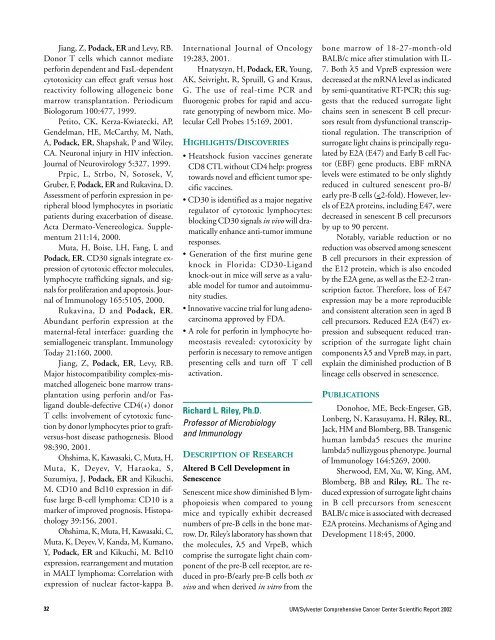tumor cell biology program - Sylvester Comprehensive Cancer Center
tumor cell biology program - Sylvester Comprehensive Cancer Center
tumor cell biology program - Sylvester Comprehensive Cancer Center
Create successful ePaper yourself
Turn your PDF publications into a flip-book with our unique Google optimized e-Paper software.
Jiang, Z, Podack, ER and Levy, RB.<br />
Donor T <strong>cell</strong>s which cannot mediate<br />
perforin dependent and FasL-dependent<br />
cytotoxicity can effect graft versus host<br />
reactivity following allogeneic bone<br />
marrow transplantation. Periodicum<br />
Biologorum 100:477, 1999.<br />
Petito, CK, Kerza-Kwiatecki, AP,<br />
Gendelman, HE, McCarthy, M, Nath,<br />
A, Podack, ER, Shapshak, P and Wiley,<br />
CA. Neuronal injury in HIV infection.<br />
Journal of Neurovirology 5:327, 1999.<br />
Prpic, L, Strbo, N, Sotosek, V,<br />
Gruber, F, Podack, ER and Rukavina, D.<br />
Assessment of perforin expression in peripheral<br />
blood lymphocytes in psoriatic<br />
patients during exacerbation of disease.<br />
Acta Dermato-Venereologica. Supplementum<br />
211:14, 2000.<br />
Muta, H, Boise, LH, Fang, L and<br />
Podack, ER. CD30 signals integrate expression<br />
of cytotoxic effector molecules,<br />
lymphocyte trafficking signals, and signals<br />
for proliferation and apoptosis. Journal<br />
of Immunology 165:5105, 2000.<br />
Rukavina, D and Podack, ER.<br />
Abundant perforin expression at the<br />
maternal-fetal interface: guarding the<br />
semiallogeneic transplant. Immunology<br />
Today 21:160, 2000.<br />
Jiang, Z, Podack, ER, Levy, RB.<br />
Major histocompatibility complex-mismatched<br />
allogeneic bone marrow transplantation<br />
using perforin and/or Fasligand<br />
double-defective CD4(+) donor<br />
T <strong>cell</strong>s: involvement of cytotoxic function<br />
by donor lymphocytes prior to graftversus-host<br />
disease pathogenesis. Blood<br />
98:390, 2001.<br />
Ohshima, K, Kawasaki, C, Muta, H,<br />
Muta, K, Deyev, V, Haraoka, S,<br />
Suzumiya, J, Podack, ER and Kikuchi,<br />
M. CD10 and Bcl10 expression in diffuse<br />
large B-<strong>cell</strong> lymphoma: CD10 is a<br />
marker of improved prognosis. Histopathology<br />
39:156, 2001.<br />
Ohshima, K, Muta, H, Kawasaki, C,<br />
Muta, K, Deyev, V, Kanda, M, Kumano,<br />
Y, Podack, ER and Kikuchi, M. Bcl10<br />
expression, rearrangement and mutation<br />
in MALT lymphoma: Correlation with<br />
expression of nuclear factor-kappa B.<br />
International Journal of Oncology<br />
19:283, 2001.<br />
Hnatyszyn, H, Podack, ER, Young,<br />
AK, Seivright, R, Spruill, G and Kraus,<br />
G. The use of real-time PCR and<br />
fluorogenic probes for rapid and accurate<br />
genotyping of newborn mice. Molecular<br />
Cell Probes 15:169, 2001.<br />
HIGHLIGHTS/DISCOVERIES<br />
• Heatshock fusion vaccines generate<br />
CD8 CTL without CD4 help: progress<br />
towards novel and efficient <strong>tumor</strong> specific<br />
vaccines.<br />
• CD30 is identified as a major negative<br />
regulator of cytotoxic lymphocytes:<br />
blocking CD30 signals in vivo will dramatically<br />
enhance anti-<strong>tumor</strong> immune<br />
responses.<br />
• Generation of the first murine gene<br />
knock in Florida: CD30-Ligand<br />
knock-out in mice will serve as a valuable<br />
model for <strong>tumor</strong> and autoimmunity<br />
studies.<br />
• Innovative vaccine trial for lung adenocarcinoma<br />
approved by FDA.<br />
• A role for perforin in lymphocyte homeostasis<br />
revealed: cytotoxicity by<br />
perforin is necessary to remove antigen<br />
presenting <strong>cell</strong>s and turn off T <strong>cell</strong><br />
activation.<br />
Richard L. Riley, Ph.D.<br />
Professor of Micro<strong>biology</strong><br />
and Immunology<br />
DESCRIPTION OF RESEARCH<br />
Altered B Cell Development in<br />
Senescence<br />
Senescent mice show diminished B lymphopoiesis<br />
when compared to young<br />
mice and typically exhibit decreased<br />
numbers of pre-B <strong>cell</strong>s in the bone marrow.<br />
Dr. Riley’s laboratory has shown that<br />
the molecules, λ5 and VrpeB, which<br />
comprise the surrogate light chain component<br />
of the pre-B <strong>cell</strong> receptor, are reduced<br />
in pro-B/early pre-B <strong>cell</strong>s both ex<br />
vivo and when derived in vitro from the<br />
bone marrow of 18-27-month-old<br />
BALB/c mice after stimulation with IL-<br />
7. Both λ5 and VpreB expression were<br />
decreased at the mRNA level as indicated<br />
by semi-quantitative RT-PCR; this suggests<br />
that the reduced surrogate light<br />
chains seen in senescent B <strong>cell</strong> precursors<br />
result from dysfunctional transcriptional<br />
regulation. The transcription of<br />
surrogate light chains is principally regulated<br />
by E2A (E47) and Early B <strong>cell</strong> Factor<br />
(EBF) gene products. EBF mRNA<br />
levels were estimated to be only slightly<br />
reduced in cultured senescent pro-B/<br />
early pre-B <strong>cell</strong>s (
















